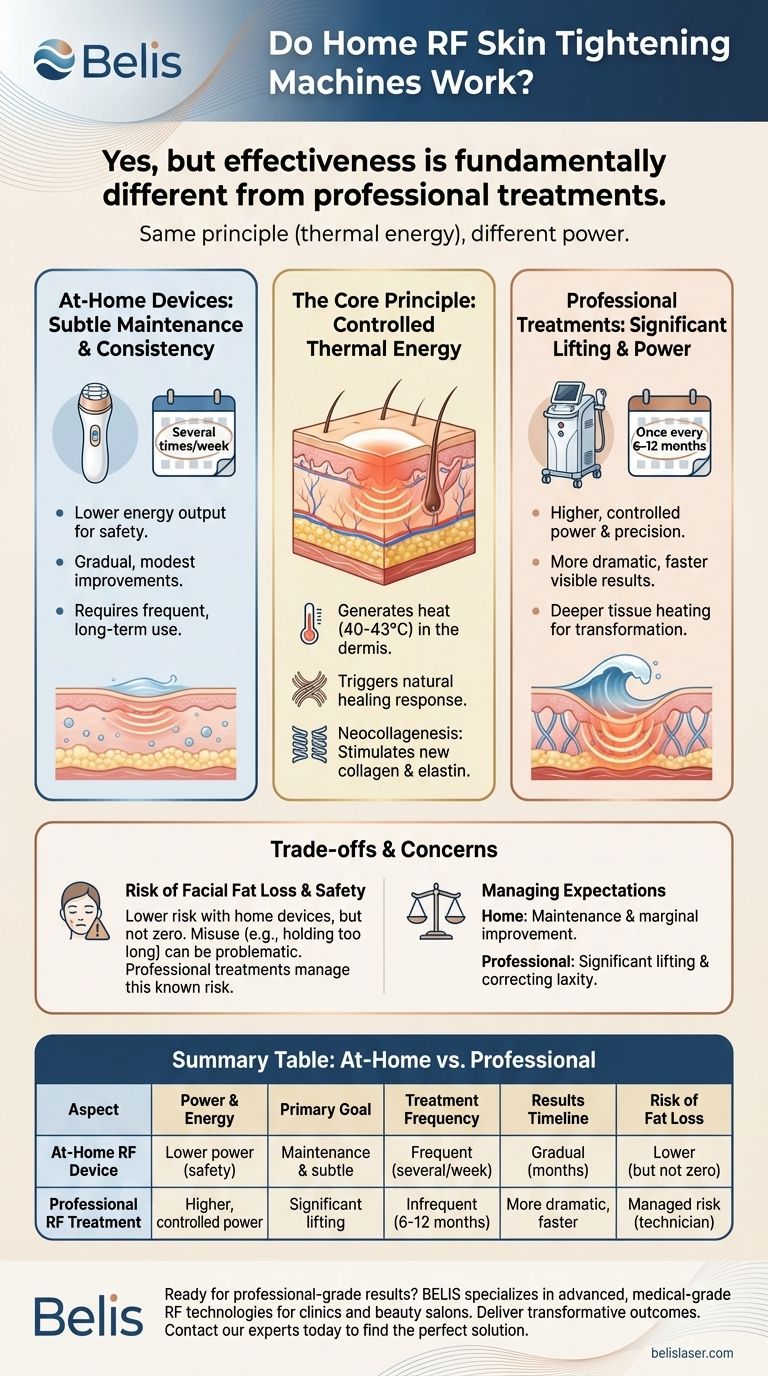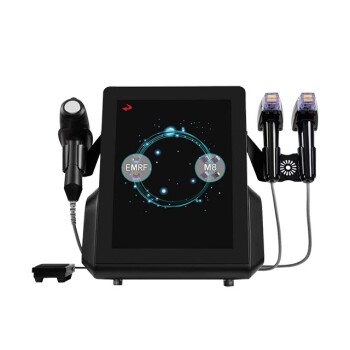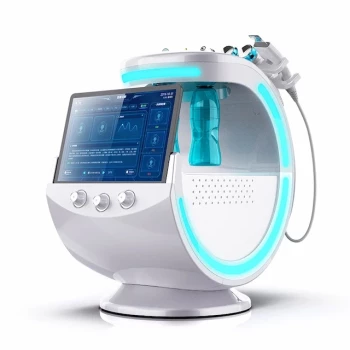Yes, at-home radiofrequency (RF) skin tightening machines do work, but their effectiveness is fundamentally different from professional treatments. They operate on the same scientific principle of using thermal energy to stimulate collagen production in the deeper layers of your skin. However, the results are more subtle and require consistent, long-term use to achieve and maintain.
The core difference lies in power. At-home devices are engineered with lower energy output for safety, leading to modest improvements and maintenance. Professional machines deliver more powerful, controlled energy for more significant and faster results.

How Radiofrequency Actually Tightens Skin
The Core Principle: Controlled Thermal Energy
Radiofrequency devices work by generating and delivering electrical energy that penetrates the skin's outer layer (epidermis). This energy creates gentle, deep heat within the dermis, the layer where your collagen and elastin fibers reside.
This process is based on the principle of controlled thermal injury.
Triggering the Body's Healing Response
When the dermis is heated to a specific, controlled temperature (typically around 40-43°C), the body interprets it as a mild injury. This triggers a natural healing cascade.
The immediate effect is the contraction of existing collagen fibers, which provides a temporary, subtle tightening. More importantly, this process signals your cells (fibroblasts) to produce new, stronger collagen and elastin over the following weeks and months. This long-term effect is known as neocollagenesis.
The Critical Difference: At-Home vs. Professional
Power and Depth of Penetration
Professional RF machines used in a clinical setting are significantly more powerful. They can deliver higher temperatures to deeper layers of the skin with extreme precision, leading to a more robust collagen response and more dramatic results.
At-home devices are intentionally designed with lower power caps to ensure user safety, meaning they heat the tissue less intensely and often more superficially.
Consistency Over Intensity
A professional treatment might be done once every 6-12 months. An at-home device, due to its lower power, requires a much higher frequency of use—often several times a week—to accumulate a therapeutic effect.
The goal with home devices is to consistently stimulate collagen just enough to see subtle firming and potentially slow the signs of aging, not to replicate a clinical outcome.
Understanding the Trade-offs and Concerns
The Risk of Facial Fat Loss
This is a valid and frequently discussed concern. Unwanted fat reduction can occur if the RF energy heats the subcutaneous fat layer to a temperature that damages fat cells (a process called apoptosis).
With powerful professional devices, this is a known risk that trained technicians mitigate with specific techniques and advanced cooling systems. For lower-power home devices, the risk is substantially lower but not zero. Incorrect use, such as holding the device in one spot for too long, could theoretically cause unwanted effects.
Safety and User Error
While at-home devices are generally safe due to their power limitations, the primary risk comes from user error. Leaving the device on one area for too long or using an improper technique can lead to superficial burns, redness, or temporary swelling.
It is critical to follow the manufacturer's instructions precisely, always keep the device moving, and use the recommended conductive gel.
Managing Expectations for Results
An at-home RF device will not produce the same results as a non-surgical facelift or a professional treatment course. Its effects are best described as maintenance and marginal improvement.
Users who see the best results are typically those looking to maintain skin firmness, slightly soften fine lines, or enhance the results of previous professional treatments.
Making the Right Choice for Your Goal
Deciding whether an at-home RF device is right for you depends entirely on your expectations and goals.
- If your primary focus is significant lifting and correcting moderate to severe skin laxity: Professional treatments are the most effective and reliable path to achieving your desired results.
- If your primary focus is maintenance or achieving subtle firming: An at-home device can be a valuable tool, but only if you are committed to the consistent, long-term treatment schedule required.
- If your primary focus is safety and avoiding downtime: A well-chosen at-home device, used correctly, offers a lower-risk approach to skin rejuvenation, but with correspondingly milder outcomes.
Ultimately, understanding the limitations of at-home technology is the key to being satisfied with your decision and your results.
Summary Table:
| Aspect | At-Home RF Device | Professional RF Treatment |
|---|---|---|
| Power & Energy | Lower power for safety | Higher, controlled power |
| Primary Goal | Maintenance & subtle improvement | Significant lifting & tightening |
| Treatment Frequency | Frequent (e.g., several times/week) | Infrequent (e.g., once every 6-12 months) |
| Results Timeline | Gradual, over months of consistent use | More dramatic and faster visible results |
| Risk of Fat Loss | Lower risk, but not zero with misuse | A known risk, managed by technician |
Ready for professional-grade results?
At-home devices are for maintenance, but for significant, safe, and clinically-proven skin tightening, professional equipment is essential.
BELIS specializes in advanced, medical-grade RF and aesthetic technologies for clinics and premium beauty salons. Our machines deliver the powerful, controlled energy needed for transformative outcomes that clients demand.
Elevate your treatment offerings and ensure client satisfaction. Contact our experts today to find the perfect professional solution for your practice.
Visual Guide

Related Products
- Ultrasonic Cavitation Radiofrecuency Machine for Body Slimming
- Cryolipolysis Fat Freezing Machine and Ultrasonic Cavitation Device
- IPL SHR+Radio frecuency machine
- 4D 12D HIFU Machine Device for Skin Tightening and Lifting
- RF Microneedling Machine Micro Needle Radio Frequency Machine
People Also Ask
- What are the negative side effects of cavitation? Understanding the Risks for Your Practice
- What does a cavitation machine do for your body? Sculpt Your Contours Without Surgery
- When should you not use a cavitation machine? Critical Safety Guidelines for Aesthetic Treatments
- Where does fat go after cavitation? Understand the Journey from Cell to Elimination
- Does ultrasound really break down fat? Discover the Science of Non-Invasive Fat Reduction



















